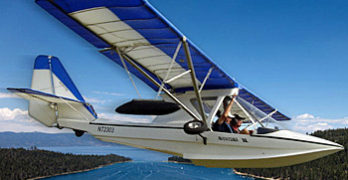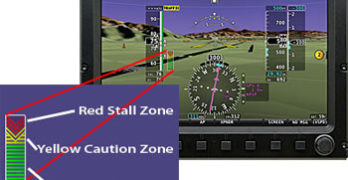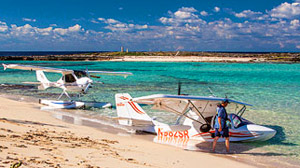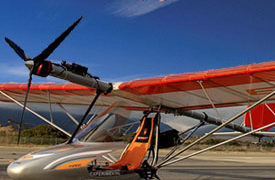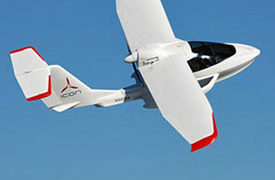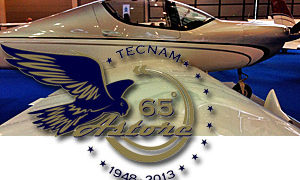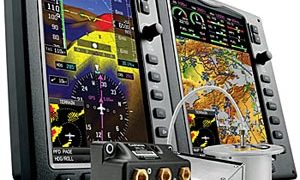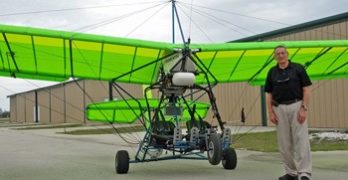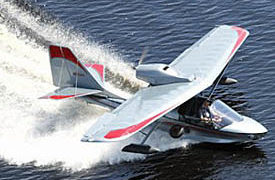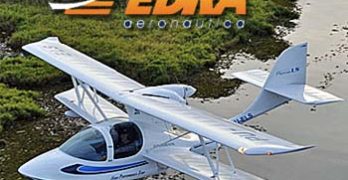Icon Aircraft receives a high percentage of the attention paid to LSA seaplanes. They’ve worked hard on marketing and been quite successful; their Facebook page has nearly 300,000 “Likes!” Yet, as I’ve written, this is a growing subset within the LSA industry with several interesting designs already flying plus new ones to come that are really going to widen people’s eyes. However, some of that remains in the future while we have present-day success stories. If you want a seaplane you can afford and you want it soon, you have several choices, for example: Progressive Aerodyne’s SeaRey and the hot little SeaMax, both of which are SLSA approved, plus Edra Aeronautica’s Super Petrel LS, and in the world of light kits, don’t forget another longtime player, Aero Adventure. The latter Florida company recently reported news.
“Here We Come Tavares,” exclaimed a recent newsletter from Aero Adventure!
Search Results for : Icon
Not finding exactly what you expected? Try our advanced search option.
Select a manufacturer to go straight to all our content about that manufacturer.
Select an aircraft model to go straight to all our content about that model.
Avionics World: Changes for Your Panel
Dynon gathers little moss it appears. The SkyView builder has been upgrading software, releasing new products and now, the Woodinville, Washington company has acquired Advanced Flight Systems (AFS). Dynon said they did the acquisition, “… to use Dynon’s financial strength to keep AFS strong and vibrant in the experimental community.” It appears to be a pure financial move as the two companies will continue to operate with full autonomy, according to a Dynon FAQ series. • Another reason to buy a former “friendly competitor” is to get more deeply involved with Angle of Attack (AoA) indicators, which are causing a significant buzz. “AFS holds patents on Angle of Attack (AoA) technology and has long been a leader with AoA products,” reported Dynon. As you’ll read below, Icon is pushing the instrument and others are singing the praises of AoA, yet fighter aircraft and airliners have had the technology for years.
Still Expanding LSA Seaplane Development
“Isn’t it just a niche market?,” asked a reader in a recent email. The query came after he read about a flurry of new seaplanes and the writer wondered if it could be worth all the investment pouring in to these projects. Development progress in this particular sector-within-a-sector (LSA seaplanes) seems to be far outdistancing development in other parts of the aviation world. So, are efforts to develop increasingly sophisticated LSA seaplanes economically justifiable? It’s a worthy question. Another answer: “Well, why not?” An amphibious LSA seaplane can land on water or land, could fly as fast or nearly as fast as a land plane. They can look cleaner with gear that disappears. They already have another 110 pounds to work with (though admittedly much of that is needed simply to achieve an amphib seaplane and even that is not enough for all manufacturers). If you want an LSA, why not one that’s more versatile?
New Manufacturer of Electric Aircraft
Once upon a time the light aircraft industry announced new manufacturers and models at the rate of two, three, or even more every month …for several years. As with every maturing industry before, this torrid pace had to slow. Yet the party isn’t over, far from it. Contrarily, I am aware of several new projects in the works and we all know of some (Icon, Terrafugia, Lisa among others) where companies have been working on their designs for some years but they have yet to secure FAA approval as a Light-Sport Aircraft. Neither has GreenWing International, a new company announced this week though that may change quickly enough.
“Yuneec International, a world leader in electric power systems, is proud to announce the formation of GreenWing International, [which is] entirely focused on bringing the revolution of electric power to the global general aviation market,” announced company CEO Tian Yu. Enthusiasts following electric powered aircraft development first saw Yuneec’s e430 at AirVenture 2009.
Light Aircraft Weight … More or Less?
Several aviation sources recently carried news about Icon Aircraft and their A5 LSA seaplane development. Icon Aircraft has been waiting — surely with increasing impatience — for FAA to answer their formal request for exemption to the Light-Sport Aircraft gross weight parameter. FAA normally replies in 120 days, however, more than a year passed and all that arrived was a request for more detail. One can imagine the cries of angst at Icon. Many have wondered when (or if) this handsome aircraft will go to market but if you were part of their leadership, what would you go into production with … a 1,430-pound seaplane or one at the new requested weight of 1,680 pounds? Either way, what if FAA later changed their mind about an exemption they might grant. Recent news about the IRS makes us all aware government agencies don’t always operate as we expect. What a vexing situation for Team Icon.
Finishing Four Amazing Days at Aero 2013
Airplane Overload — Imagine a gymnasium, the full court kind where basketball is played. Imagine ten of them placed side by side. Big space, huh? Now imagine all of them filled to capacity with aircraft and airplane gear of every imaginable sort. Presto! You’ve got Aero Friedrichshafen. No wonder we go year after year (I think this was my tenth Aero and, for certain, I’m going again). In this wrap up post, I’ll provide a few more views of this truly excellent event. Good as my reporting hopefully is, however, true-blue aviation enthusiasts owe it to themselves to make the trip to the southern edge of Germany for this outstanding (nearly) all-indoor aviation extravaganza. I can find so many good reasons to like Aero, I’m sure you’d be pleased if you attend.
Final Facts and Videos — Aero Show Director Roland Bosch somehow made time in what must be an awesomely tight schedule to let us tape a video with him and his U.S.
Garmin Team X on a LSA Development Tear
Next month, in April 2013, the Light-Sport Aircraft industry celebrates an anniversary. It will be the eighth year since the first Special LSA approval was granted by an FAA Designated Airworthiness Representative in 2005. Evektor‘s Sportstar was first, followed hours later by the Flight Design CT and then an amazing outpouring of innovation now stretching to 131 SLSA models approved. That’s better than four brand new aircraft every quarter for 32 straight quarters; worldwide aviation’s never seen anything like it. Most of the early brand names in the industry were new, at least to Americans. Yet along the way, some famous aviation names joined the party.
We’ve seen entries from Piper, Cirrus, Cessna, Lycoming, Sensenich, and Wipaire Floats plus the major member organizations embraced Light-Sport in their own way. One multibillion dollar company to serve the sport and recreation community has been Garmin.
50 Years with No Crashes…and 25 of them In A Quick!
It’s enough to be proud of flying a “real” airplane for 50 years without accident, incident, or citation for 50 years. But imagine if half of those years were flown in those crazy “death wish” machines: ultralights! Of course, those of us who’ve flown hang gliders, ultralights and other true bird experience aircraft know just how safe they are. Anything you fly requires skill but also flying it within its strengths and limitations – that’s the only fail-safe secret to safe flying.
Nobody knows that truth better than George Karamitis. He’s just received the FAA’s Wright Brothers Master Pilot Award, for half a century of impeccable flying in both GA airplanes and the all-time best selling ultralight, the Quicksilver. George started out like a lot of us did, gawking through the fence as a kid at his home airport, Oshkosh’s Wittman Field. The veteran aviation icon and airport namesake himself, Steve Wittman, gave wee Georgie a ride one day, which sure beat hanging out in the family bathroom at home, as he liked to do, sitting on the toilet seat lid and pretending to fly with a plunger for a joystick!
Seaplane Tsunami — Water-Borne Flying Fun
Once upon a time, in the early days of Light-Sport Aircraft, way back in 2006 and 2007, new LSA models were being introduced at the torrid pace of two, three, even four per month. Aviation had no prior design outpouring to compare. The rate of development had to slow — such a pace is not sustainable — and it did. Yet the young industry continued on to the astonishing sum of 131 models and it ain’t over yet. Meanwhile, though, a new tsunami is building within the LSA sector. I’ve written about a wave a new seaplanes and as summer 2013 approaches, a tour of the many choices may help guide interest of seaplane enthusiasts.
Current Seaplanes (distinguished from float-equipped land planes *) include FAA-accepted SLSA models: Mermaid, SeaMax, SeaRey, and Freedom. At present all are being offered and have some measure of U.S.
More LSA Seaplanes … How About A Biplane Amphib?
Sebring starts next week … yes, next week! A new year is here and for nine years now that means it is time for the Sebring U.S. Sport Aviation Expo, or just Sebring LSA Expo if you prefer. Executive Director Jana Filip and her team have been putting in the long hours to get ready and to enlist all the right exhibitors. You should get to see all the Light-Sport and other light aircraft you want in this concentrated event. One of those aircraft has not been seen in America for years and even then not as the Super Petrel LS. Longtime veterans of recreational aircraft might remember the Petrel — it’s been around for more than 10 years — but this soon-to-be SLSA entrant will look fresh to nearly everyone.
New Flight Design dealer and Florida Light-Sport Aviation owner Brian Boucher is assisting airport neighbor Jerry Scheid to bring this first-of-its-kind Super Petrel LS to Sebring for your closer examination.
- « Previous Page
- 1
- …
- 19
- 20
- 21
- 22
- 23
- …
- 28
- Next Page »


